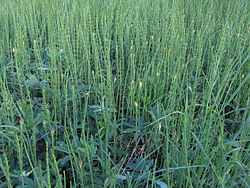Equisetopsida: Perbedaan antara revisi
Konten dihapus Konten ditambahkan
Add 2 books for Wikipedia:Pemastian (20210309)) #IABot (v2.0.8) (GreenC bot |
k v2.04b - Fixed using Wikipedia:ProyekWiki Cek Wikipedia (Tanda baca setelah kode "<nowiki></ref></nowiki>") |
||
| Baris 12: | Baris 12: | ||
}} |
}} |
||
'''Equisetopsida''', atau '''Sphenopsida''' di kalangan [[paleobotani]], adalah salah satu [[Kelas (biologi)|kelas]] [[tumbuhan berpembuluh]] yang masih lestari hingga kini namun dengan temuan fosil berusia sampai ke kala [[Devon (periode)|Devon]]. Anggotanya yang banyak dikenal adalah [[paku ekor kuda]] (''Equisetum'')<ref>{{cite web | url = http://www.merriam-webster.com/cgi-bin/dictionary?book=Dictionary&va=horsetail | title = horsetail | work = Merriam-Webster Online Dictionary }}</ref><ref name="Allaby 1999">{{cite book|last= Allaby|first= Ailsa|author2=Michael Allaby|year= 1999|title= "Sphenopsida." A Dictionary of Earth Sciences |url= https://archive.org/details/dictionaryofeart00alla}}</ref><ref name=Judd>{{cite book|last1=Judd|first1=W.S.|last2=Campbell|first2=C.S.|last3=Kellogg|first3=E.A.|last4=Stevens|first4=P.F.|last5=Donoghue|first5=M.J.|year=2002|title=Plant systematics, a phylogenetic approach.|publisher=Sinauer Associates, Inc.|location=Sunderland, Massachusetts|isbn=0878934030|page=193 }}</ref> |
'''Equisetopsida''', atau '''Sphenopsida''' di kalangan [[paleobotani]], adalah salah satu [[Kelas (biologi)|kelas]] [[tumbuhan berpembuluh]] yang masih lestari hingga kini namun dengan temuan fosil berusia sampai ke kala [[Devon (periode)|Devon]]. Anggotanya yang banyak dikenal adalah [[paku ekor kuda]] (''Equisetum'').<ref>{{cite web | url = http://www.merriam-webster.com/cgi-bin/dictionary?book=Dictionary&va=horsetail | title = horsetail | work = Merriam-Webster Online Dictionary }}</ref><ref name="Allaby 1999">{{cite book|last= Allaby|first= Ailsa|author2=Michael Allaby|year= 1999|title= "Sphenopsida." A Dictionary of Earth Sciences |url= https://archive.org/details/dictionaryofeart00alla}}</ref><ref name=Judd>{{cite book|last1=Judd|first1=W.S.|last2=Campbell|first2=C.S.|last3=Kellogg|first3=E.A.|last4=Stevens|first4=P.F.|last5=Donoghue|first5=M.J.|year=2002|title=Plant systematics, a phylogenetic approach.|publisher=Sinauer Associates, Inc.|location=Sunderland, Massachusetts|isbn=0878934030|page=193 }}</ref> Kebanyakan anggotanya menyukai tempat yang becek / berair, dengan daun yang sangat tereduksi sehingga fotosintesis dilakukan oleh batang, yang umumnya beruas dan berbentuk berkas-berkas kaku. |
||
<!-- |
<!-- |
||
The Equisetopsida were formerly regarded as a separate [[division (biology)|division]] of spore plants and also called '''Equisetophyta''', '''Arthrophyta''' or '''Sphenophyta'''; today they have been recognized as rather close relatives of the typical ferns ([[Pteridopsida]]) and form a specialized lineage of the [[Pteridophyta]].<ref name="Smith 2006">{{cite journal | doi=10.2307/25065646 | last=Smith | first=Alan R.|author2=Kathleen M. Pryer |author3=Eric Schuettpelz |author4=Petra Korall |author5=Harald Schneider |author6=Paul G. Wolf | year=2006 | title= A classification for extant ferns | url=http://www.pryerlab.net/publication/fichier749.pdf | journal=Taxon | volume= 55 | issue=3 | pages= 705–731 | jstor=25065646 }}</ref> |
The Equisetopsida were formerly regarded as a separate [[division (biology)|division]] of spore plants and also called '''Equisetophyta''', '''Arthrophyta''' or '''Sphenophyta'''; today they have been recognized as rather close relatives of the typical ferns ([[Pteridopsida]]) and form a specialized lineage of the [[Pteridophyta]].<ref name="Smith 2006">{{cite journal | doi=10.2307/25065646 | last=Smith | first=Alan R.|author2=Kathleen M. Pryer |author3=Eric Schuettpelz |author4=Petra Korall |author5=Harald Schneider |author6=Paul G. Wolf | year=2006 | title= A classification for extant ferns | url=http://www.pryerlab.net/publication/fichier749.pdf | journal=Taxon | volume= 55 | issue=3 | pages= 705–731 | jstor=25065646 }}</ref> |
||
| Baris 57: | Baris 57: | ||
Recent [[phylogenetics|phylogenetic analysis]] has produced evidence that this group of plants belongs firmly within the [[fern]] [[clade]] of [[vascular plants]].<ref name="Pryer 2001">{{cite journal | last=Pryer | first=Kathleen M. |author2=Harald Schneider |author3=Alan R. Smith |author4=Raymond Cran |author5=Paul G. Wolf |author6=Jeffrey S. Hunt |author7=Sedonia D. Sipes| year=2001 | title= Horsetails and ferns are a monophyletic group and the closest living relatives to seed plants | url=http://www.pryerlab.net/publication/fichier199.pdf | journal=Nature | volume= 409 | pages= 618–621 | pmid = 11214320 | doi=10.1038/35054555 | issue=6820 }}</ref> A 2006 classification by Smith ''et al.'' places the class Equisetopsida within an unranked clade of broadly defined ferns, as a sister to two classes more traditionally called ferns, Marattiopsida and Polypodiopsida.<ref name="Smith 2006"/> |
Recent [[phylogenetics|phylogenetic analysis]] has produced evidence that this group of plants belongs firmly within the [[fern]] [[clade]] of [[vascular plants]].<ref name="Pryer 2001">{{cite journal | last=Pryer | first=Kathleen M. |author2=Harald Schneider |author3=Alan R. Smith |author4=Raymond Cran |author5=Paul G. Wolf |author6=Jeffrey S. Hunt |author7=Sedonia D. Sipes| year=2001 | title= Horsetails and ferns are a monophyletic group and the closest living relatives to seed plants | url=http://www.pryerlab.net/publication/fichier199.pdf | journal=Nature | volume= 409 | pages= 618–621 | pmid = 11214320 | doi=10.1038/35054555 | issue=6820 }}</ref> A 2006 classification by Smith ''et al.'' places the class Equisetopsida within an unranked clade of broadly defined ferns, as a sister to two classes more traditionally called ferns, Marattiopsida and Polypodiopsida.<ref name="Smith 2006"/> |
||
--> |
--> |
||
Hubungan antarkelompok di dalam Equisetopsida menurut salah satu versi ditunjukkan dengan kladogram berikut<ref>{{cite web|title=Introduction to the Sphenophyta|url=http://www.ucmp.berkeley.edu/plants/sphenophyta/sphenophyta.html|publisher=University of California Museum of Paleontology|accessdate=31 July 2011}}</ref> |
Hubungan antarkelompok di dalam Equisetopsida menurut salah satu versi ditunjukkan dengan kladogram berikut.<ref>{{cite web|title=Introduction to the Sphenophyta|url=http://www.ucmp.berkeley.edu/plants/sphenophyta/sphenophyta.html|publisher=University of California Museum of Paleontology|accessdate=31 July 2011}}</ref> |
||
{{clade|style=line-height:100%; |
{{clade|style=line-height:100%; |
||
|1={{clade |
|1={{clade |
||
Revisi per 24 Juni 2021 04.16
| Equisetopsida
| |
|---|---|
| Taksonomi | |
| Superkerajaan | Eukaryota |
| Kerajaan | Plantae |
| Divisi | Equisetophyta |
| Kelas | Equisetopsida C.Agardh, 1825 |
| Tata nama | |
| Sinonim takson | Sphenopsida |
| Ordo | |
Equisetopsida, atau Sphenopsida di kalangan paleobotani, adalah salah satu kelas tumbuhan berpembuluh yang masih lestari hingga kini namun dengan temuan fosil berusia sampai ke kala Devon. Anggotanya yang banyak dikenal adalah paku ekor kuda (Equisetum).[1][2][3] Kebanyakan anggotanya menyukai tempat yang becek / berair, dengan daun yang sangat tereduksi sehingga fotosintesis dilakukan oleh batang, yang umumnya beruas dan berbentuk berkas-berkas kaku.
Klasifikasi
Hubungan antarkelompok di dalam Equisetopsida menurut salah satu versi ditunjukkan dengan kladogram berikut.[4]
| ||||||||||||||||||||||||||||
Referensi
- ^ "horsetail". Merriam-Webster Online Dictionary.
- ^ Allaby, Ailsa; Michael Allaby (1999). "Sphenopsida." A Dictionary of Earth Sciences.
- ^ Judd, W.S.; Campbell, C.S.; Kellogg, E.A.; Stevens, P.F.; Donoghue, M.J. (2002). Plant systematics, a phylogenetic approach. Sunderland, Massachusetts: Sinauer Associates, Inc. hlm. 193. ISBN 0878934030.
- ^ "Introduction to the Sphenophyta". University of California Museum of Paleontology. Diakses tanggal 31 July 2011.
Wikispecies mempunyai informasi mengenai Equisetopsida.
Wikimedia Commons memiliki media mengenai Equisetopsida.

